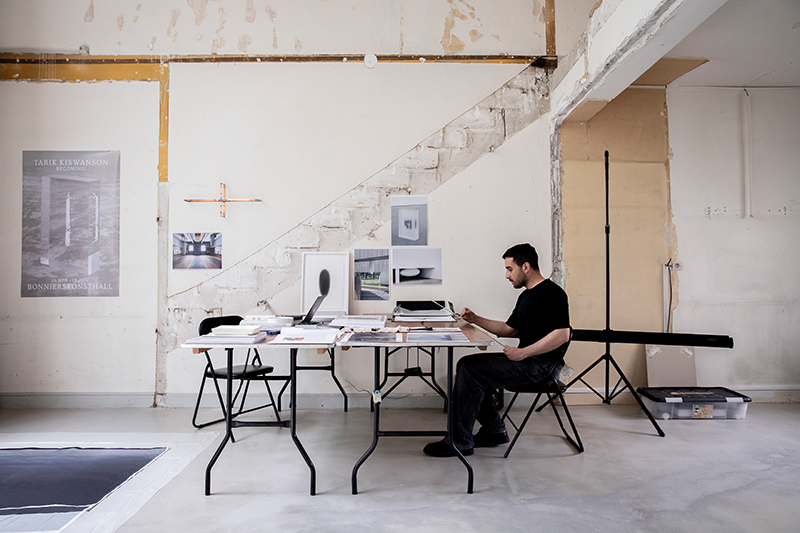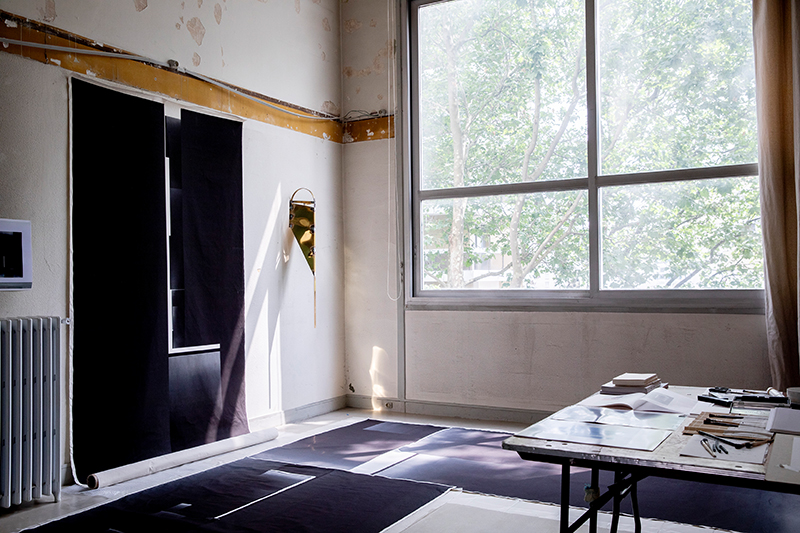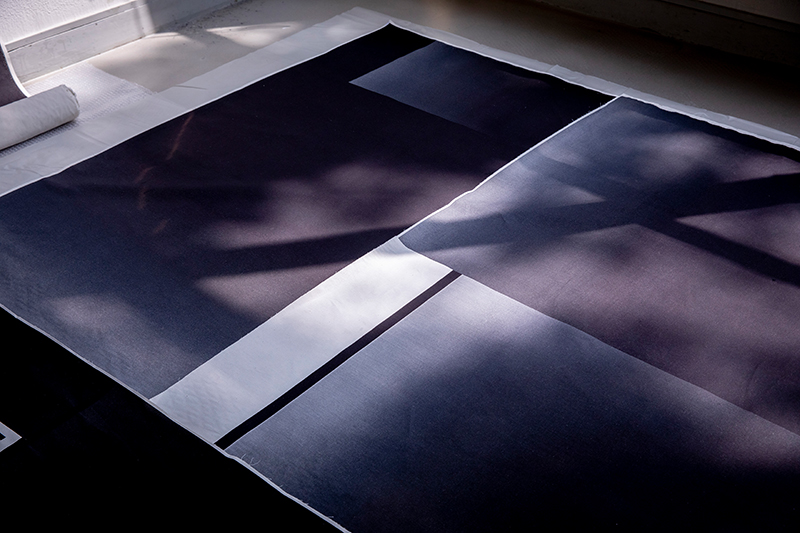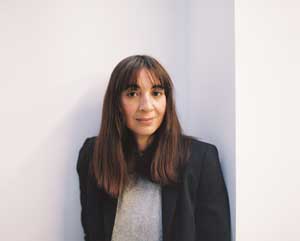![[Translate to English:] [Translate to English:]](/fileadmin/_processed_/1/0/csm_tarikbandeau_c8838fecd4.jpg)
Tarik Kiswanson’s contemporary cosmology
A strange scene unfolded before visitors’ eyes at the 16th Lyon Biennale of Contemporary Art last fall. One of the historic galleries at the heart of the Musée Guimet seemed to have been turned upside down – two empty display cases and a metal desk had flown up from the floor and stuck to the ceiling. Three immense white cocoons, nearly three meters in height, hung beside them. This antiquated space became a frozen spectacle of life captured in the process of germination, with a science fiction flavor.
In collaboration with Paris+ par Art Basel
The author of this stunning installation, Tarik Kiswanson, is a master at creating a world in suspense through his ambiguous, subtle, and striking works – which include sculpture, but also painting, drawing, performance, and poetry. In so doing he extols the vulnerability of our world and of those who inhabit it.
For the past three years, the 37-year-old artist, who was awarded the Prix Marcel Duchamp 2023, has been spreading his giant cocoons across the four corners of the earth. From the rooms of the Carré d’Art in Nîmes to those of the Bonniers Konsthall in Stockholm, to the luminous courtyard of the Museo Tamayo in Mexico, his ovoid sculptures variously nestle horizontally beneath a white cabinet, line up along a wall, or embed themselves in a doorframe, thus obstructing it. These placements reflect the artist’s own situation, floating in the margins without ever completely fitting into the frame.
As a second-generation immigrant, my story is shaped by displacement and uprooting.
Tarik Kiswanson
‘As a second-generation immigrant, my story is shaped by displacement and uprooting,’ says the artist. Born in the small town of Halmstad, Sweden to Palestinian parents exiled in the 1970s, Kiswanson has always kept one foot planted in the country of his birth and the other in the Middle East, where he has traveled every year since he was born. Like many second-generation immigrants, he suffered from the imperatives of conformism and integration in his family’s adopted country while constantly being reminded of his roots by the predominantly white societies in which he has lived – first Sweden, and now Paris, which has been home for the past 14 years.
In his sculptures and drawings, Kiswanson materializes the experience of being uprooted through an interstitial body of work situated between the realm of the tangible and the elusive.
In his sculptures and drawings, Kiswanson materializes the experience of being uprooted through an interstitial body of work situated between the realm of the tangible and the elusive. Affixed to the wall, his silver- and copper-colored metal plates reveal their supporting structures through striated openings – material respirations of a sort – and raised strips creating a relief. These immobile works are transformed by the movements of light and viewers animating their reflective surfaces.
Fragments of juvenile bodies drawn meticulously in charcoal on paper vanish like ghosts in the uncertainty of the white surface that the artist leaves partially blank. The poetry that Kiswanson has been writing since adolescence translates this same volatility into words. ‘Through the verbal and visual sequencing of his poems on the page, his writing asserts itself as an extension of his sculptural work,’ writes the art critic Ingrid Luquet-Gad. She further describes his work as an ‘ontology of incompleteness’ – an idea that is given substance by the seemingly light mediums and materials he uses, and by their open forms that play on empty and solid spaces. In other words, Kiswanson’s work is the expression of a ‘fragility of being’ that avoids the clichés associated with this often-hackneyed notion. While some people shun the anguish of imbalance and uncertainty at all costs, he prefers to fight against the inertia of fixity, embracing in his work a ‘perpetual instability’ that keeps him in constant motion.
Kiswanson maintains this balance by way of a skillful mastery of time. In his video The Fall (2020), a young boy seated at a desk is filmed with a high-angle shot – he looks the viewer directly in the eyes as he leans back in his chair. By capturing this moment of weightlessness in slow motion, the artist breaks the narrative bookends – the initial stability and the fall to come – so as to focus on the space in between.
Having grown up far from the hustle and bustle of city life and the art world, the artist’s imagination was primarily shaped by the discovery of his double culture, learning the languages of each, and the experience of almost antagonistic environments: the vast forests and calm sea of Sweden contrasting with the arid, barren expanses of Jordan. This profound relationship to the landscape and light quickly gave rise to an intimate formal vocabulary, which the young Swedish-Palestinian artist refined over the course of his studies at Central Saint Martins in London and the École nationale supérieure des Beaux-Arts in Paris. He has since continued to develop his language of abstraction in sober, geometric forms punctuated by superimpositions, repetitions, and plays on scale. This enigmatic language encourages viewers to project their own interpretations – for, even if a number of his pieces are steeped in theoretical readings and personal family history, Kiswanson’s work is neither autobiographical nor discursive.
The series Nest is a case in point: based on his experience as an immigrant, Kiswanson combined the measurements of his own body with forms borrowed from the animal kingdom, resulting in smooth, immaculate ovals that elude precise identification. ‘I realized how much opened up for me when I began refining my forms, paring them down,’ he explains. ‘The more you reduce things to the essentials, the more you evoke images in other people’s minds. And that is where the works reveal their great complexity.’
I realized how much opened up for me when I began refining my forms, paring them down. The more you reduce things to the essentials, the more you evoke images in other people’s minds. And that is where the works reveal their great complexity.
Tarik Kiswanson
For Kiswanson, abstraction and formal refinement provide the basis of a very contemporary cosmology, where different poles and aspects of his protean work gravitate around one another like planets. Like many contemporary artists driven by questions concerning their origins, religion, sexuality, or gender, Kiswanson’s work resists all categorization. Free and self-assured, the artist and poet himself says that his aim is a ‘total art’ conceived as a continuous process in which exhibitions and mediums are simply phases in a given time and place.
In the midst of preparing his project for the Prix Marcel Duchamp, which he will unveil at the Centre Pompidou this fall, the artist confides that he is currently delving into post-World War II history and the birth of ‘disaster furniture’ (also called ‘disaster relief furniture’) – rudimentary items designed for the most destitute populations of the Postwar period, the creativity behind which the artist likes to emphasize. As for the works that will ensue from this research, the mystery remains. Like the inside of his cocoons, the moments of intense creation are not always visible to the naked eye. But with Kiswanson, there is no doubt they will result in the birth of new forms, and perhaps even new ways of being in the world. ◼
Note
* in collaboration with Paris+ Art Basel. English translation: Jacob Bromberg
Related articles
In the calendar
Artist Tarik Kiswanson in his studio, Paris, June 2023
Photo Julie Ansiau
© Centre Pompidou









